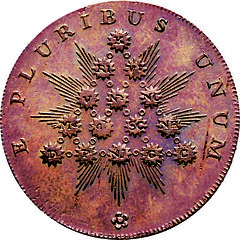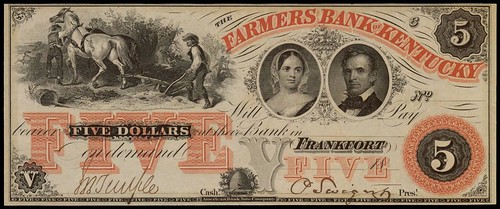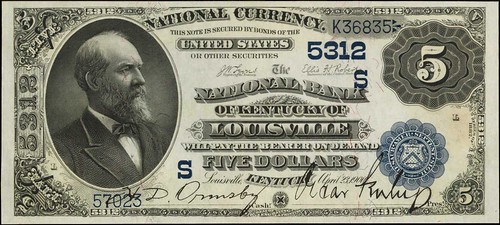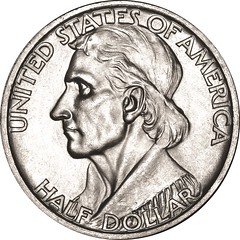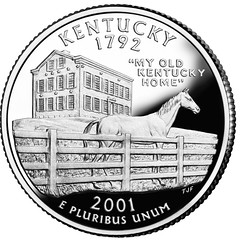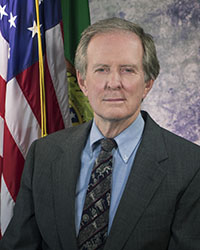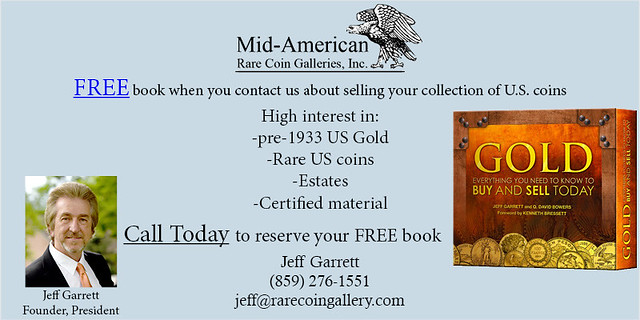
PREV ARTICLE
NEXT ARTICLE
FULL ISSUE
PREV FULL ISSUE
DENNIS TUCKER NOW A KENTUCKY COLONELCongratulations to Whitman Publisher Dennis Tucker on becoming a Kentucky Colonel! Here's the press release, which includes some great Kentucky-related numismatic items as well. -Editor
According to the Governor's Office, "The highest honor awarded by the Commonwealth of Kentucky is that of Kentucky Colonel." The Honorable Order of Kentucky Colonels defines the commission as "recognition of an individual's noteworthy accomplishments and outstanding service to our community, state, and nation." A Career in Nonfiction Publishing Tucker started his career in writing and publications management in New York. In 2004 he was hired as Publisher for Whitman Publishing, LLC, one of the nation's leading publishers of nonfiction books, then headquartered in Atlanta, Georgia. Since then the company has published more than 300 books, including many standard references, relating to the art and science of numismatics (the study of coins and related objects). Numismatics is a field that touches on all aspects of American financial and banking history, economics, artistry and design, technology, mining and metallurgy, political history, society, and culture. Tucker has also worked on books on the military history of the United States, in particular the Civil War, World War I, and World War II; the American presidency; and the U.S. Army, among other nonfiction subjects. In his role as Publisher, Tucker has served as Whitman's liaison to the U.S. Treasury Department and its agencies and bureaus including the United States Mint and the Bureau of Engraving and Printing; the U.S. Federal Reserve; the British Royal Mint; the Royal Canadian Mint; Münze Österreich; the Banco de México and Casa de Monedas de México, and other government agencies involved in financial, banking, numismatic, and monetary policy and administration; as well as the congressionally chartered American Numismatic Association, the American Numismatic Society, the Smithsonian Institution, and other nonprofit organizations. He has supported the educational goals of these bodies, and promoted them through the publication of related books. Numismatic Lecturer and Educator Tucker has lectured nationwide on the subject of numismatics, on topics ranging from American federal bullion programs to World War I medals, ancient coins, Mexican money, and U.S. paper currency. He has taught courses on publishing, writing, and research, and has mentored young writers in these fields. He has written hundreds of articles, published nationally, on various numismatic topics, encouraging the study and appreciation of American coins, medals, tokens, and paper money as a way of understanding the history of the United States and the life of its people. Currently serving his second four-year term as the numismatic specialist on the U.S. Treasury Department's Citizens Coinage Advisory Committee (CCAC), Tucker has advised Treasury Secretaries Jacob Lew, Steven Mnuchin, and Janet Yellen on coinage and medal design. Kentucky's Role in American Numismatics There are many numismatic items related to the Commonwealth of Kentucky, including coins, medals, tokens, and paper money. A popularly collected British token of the 1790s, known as the "Kentucky cent," depicts a pyramid of 15 state abbreviations, with K, for Kentucky, at the top. It has been featured in the Guide Book of United States Coins (the "Red Book") since the first edition was published in 1946.
The Whitman Encyclopedia of Obsolete Paper Money, volume 7, catalogs more than 150 pages of paper currency issued by 162 state-chartered banks in Kentucky. These banks circulated their own legal-tender money from the early 1800s to the late 1860s, and today collectors can acquire hundreds of rare and valuable notes as well as more affordably collectible pieces—some 1,500 types in total. They offer a rich in-depth study of small-town and big-city life in antebellum and Civil War–era Kentucky. State-chartered banks went federal as American currency started to be nationalized during the Civil War. Many Kentucky banks reorganized to purchase U.S. Treasury bonds as backing and continue to issue their own paper money as National Banks. Nearly 7,000 National Bank Notes are known from 238 charters in more than a hundred Kentucky towns and cities. Kentucky is well represented in the Guide Book of Civil War Tokens, by Q. David Bowers. During the Civil War, Kentucky merchants issued dozens of types of "storecard tokens"—privately minted bronze tokens used as small change in day-to-day transactions. As the war dragged on, increasingly nervous citizens hoarded their gold coins, then silver, and finally even copper cents, to the extent that for a time there were no legal-tender coins in circulation. Substitutes such as paper chits, encased postage stamps, and bronze tokens filled the daily need for small change. For the merchants who issued them, the tokens also served as little advertisements, promoting their names, products, and locations. Today, Kentucky's Civil War tokens are testaments to the innovation of the Commonwealth's saloonkeepers, grocers, bakers, druggists, ferrymen, manufacturers, and other merchants who issued them. Later, into the 1930s and beyond, numerous Kentucky merchants used advertising tokens to lure customers in to shop or enjoy a drink, with many tokens marked with "Good For Five Cents in Trade," "Good for One Cigar," and similar enticements. The United States issued a commemorative silver half dollar, minted from 1934 to 1938, to honor the bicentennial of Kentucky explorer Daniel Boone. The coin shows the famous frontiersman with Shawnee war chief Blackfish. More recently, the 2001 Kentucky State quarter dollar illustrates Federal Hill—"My Old Kentucky Home"—and a thoroughbred racehorse symbolic of the Commonwealth's famous bluegrass country. And Kentucky's 2016 America the Beautiful quarter dollar celebrates the Cumberland Gap, "First Doorway to the West," embodied by a rifle-bearing frontiersman. In March 2021 the Citizens Coinage Advisory Committee convened to review and discuss potential designs for Kentucky's "American Innovation" dollar coin, scheduled to be released in 2022. The CCAC's design recommendation to Treasury Secretary Yellen evokes a 45 RPM record, symbolic of Kentucky's bluegrass music and its far reach throughout the country, over radio, and in the recording industry. The image of a record and its label, inspired by Bill Monroe and the Bluegrass Boys' hit song "Blue Moon of Kentucky," is paired with silhouettes of the fiddle's classic f-shaped sound hole. Tucker's Connections to Kentucky Authors "My favorite connection to the Commonwealth," Tucker said, "is my friendship and professional collaboration with two Kentucky authors: Jeff Garrett and Michael Moran." Whitman Publishing has published award-winning books by both authors. Jeff Garrett is the founder of Mid-American Rare Coin Galleries in Lexington; a past president of both the American Numismatic Association and the Professional Numismatists Guild; and a consultant to the Smithsonian's National Numismatic Collection. He has bought, sold, and owned many of the nation's major numismatic rarities. Garrett is the senior editor of the Guide Book of United States Coins (popularly known as the "Red Book"), which celebrates its 75th edition this year. He is the author of Silver: Everything You Need to Know to Buy and Sell Today. And he has coauthored many books including the Encyclopedia of U.S. Gold Coins, 1795–1933; 100 Greatest U.S. Coins; 100 Greatest Modern U.S. Coins; and United States Coinage: A Study by Type, among others. Mike Moran is a business executive, numismatic author, lecturer, and researcher, and former chair of the advisory board of the Art Museum at the University of Kentucky. With Jeff Garrett, Moran coauthored 1849: The Philadelphia Mint Strikes Gold, which chronicles the trials and tribulations of the U.S. Mint in the first half of the 1800s and the tremendous impact that the 1848 discovery of gold in California had upon that institution and the nation as a whole. Moran's book Striking Change: The Great Artistic Collaboration of Theodore Roosevelt and Augustus Saint-Gaudens is a groundbreaking study that explores the renaissance of United States coinage at the beginning of the twentieth century. Moran is a member of the Citizens Coinage Advisory Committee. He and former CCAC chair Thomas Uram were instrumental in creation and passage of the 1921 Silver Dollar Coin Anniversary Act. The act was introduced by U.S. Representative Andy Barr of Kentucky's 6th District and signed into law this year. It mandates striking of new coins honoring the last Morgan silver dollars and the first Peace silver dollars, both types minted in 1921. "I'm honored to work with two of Kentucky's finest authors and researchers," Tucker said. "I appreciate the Governor's commission as a Kentucky Colonel, and I look forward to serving the Commonwealth as a goodwill ambassador. I will continue to enlighten people about our nation's rich numismatic history and Kentucky's important place in it." Wayne Homren, Editor The Numismatic Bibliomania Society is a non-profit organization promoting numismatic literature. See our web site at coinbooks.org. To submit items for publication in The E-Sylum, write to the Editor at this address: whomren@gmail.com To subscribe go to: https://my.binhost.com/lists/listinfo/esylum All Rights Reserved. NBS Home Page Contact the NBS webmaster 
|


